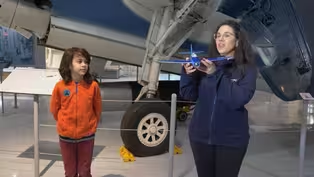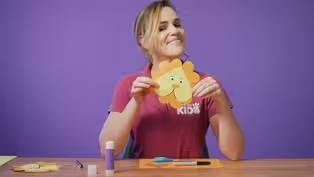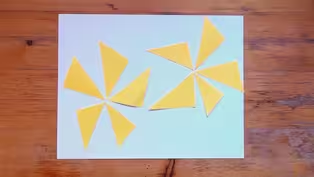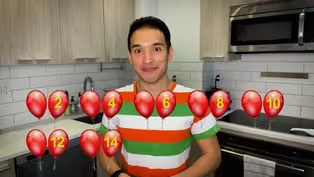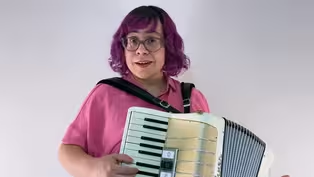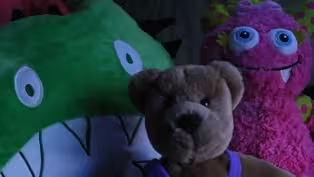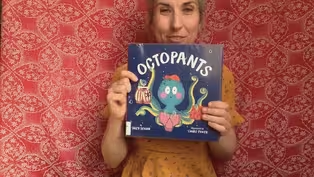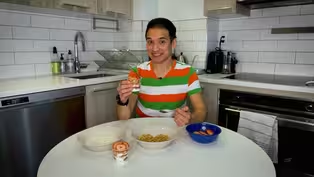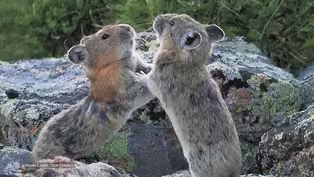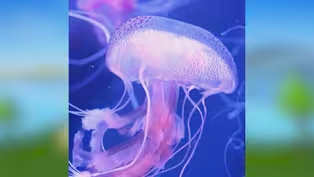
Pattern Day (Long Version)
6/23/2021 | 56m 46sVideo has Closed Captions
Dance a pattern, make a pattern parfait, play rhythmic patterns on a homemade drum!
Join head counselor Zach to dance a pattern, make a pattern parfait, play rhythmic patterns on a homemade drum. Content partners include Denver Museum of Nature and Science, Intrepid Sea, Air and Space Museum, Lincoln Center, The Museum of Modern Art, New Victory Theater, NY Philharmonic, NY Public Library, One Voice Children’s Choir, Story Pirates, the Metropolitan Museum of Art.
Problems playing video? | Closed Captioning Feedback
Problems playing video? | Closed Captioning Feedback
Camp TV is a local public television program presented by THIRTEEN PBS

Pattern Day (Long Version)
6/23/2021 | 56m 46sVideo has Closed Captions
Join head counselor Zach to dance a pattern, make a pattern parfait, play rhythmic patterns on a homemade drum. Content partners include Denver Museum of Nature and Science, Intrepid Sea, Air and Space Museum, Lincoln Center, The Museum of Modern Art, New Victory Theater, NY Philharmonic, NY Public Library, One Voice Children’s Choir, Story Pirates, the Metropolitan Museum of Art.
Problems playing video? | Closed Captioning Feedback
How to Watch Camp TV
Camp TV is available to stream on pbs.org and the free PBS App, available on iPhone, Apple TV, Android TV, Android smartphones, Amazon Fire TV, Amazon Fire Tablet, Roku, Samsung Smart TV, and Vizio.
Providing Support for PBS.org
Learn Moreabout PBS online sponsorship- Hey everybody.
My name is Zach and welcome to Camp TV.
Are you ready for some summer fun?
Me too.
Now as your head counselor, I will be introducing you to all sorts of cool activities.
Arts, crafts, games, math and science, as well as some of my favorite books, nature and theater.
I will be here to take you from one activity to the next.
So follow me on Camp TV.
[bright ambient music] - [Announcer] This program was made possible in part by the Corporation for Public Broadcasting.
A private corporation funded by the American people.
Additional funding was provided by the Peter G. Peterson and Joan Ganz Cooney Fund and the Pine Tree Foundation of New York.
- ♪ Camp TV is time for us to start ♪ ♪ From fury animal encounters, some reading and the arts ♪ ♪ No matter what the weather ♪ ♪ We'll explore it all together ♪ ♪ It's a place for you and me ♪ ♪ It is Camp TV.
♪ Oh, hi.
I almost didn't see you there.
Are you early or am I running late?
[clock ticking] Nope, you are exactly on time.
[shouts] Can you hold on for just one second?
I'm not ready yet.
Talk amongst yourselves.
What?
You look concerned?
Not enough.
That's better.
I see I may have gone a little over the top.
Oh, well that is just ridiculous.
There we go.
Much better.
Okay, let's see.
We've got some zebra stripes, we've got some polka dots and we've got some plaid.
Are you seeing a pattern yet?
Great.
Because today is pattern day on Camp TV.
Have fun at your first few activities.
Jump, dance, play, it's time to get active.
Let's move.
- Our dance challenge of the day is patterns.
Now you go, why patterns?
Why?
Why do we need them?
Well, there's patterns in almost everything.
If you really look carefully there's patterns in nature, there's patterns in math, there's patterns in the steps on the front of my house.
So today we're gonna learn a few different patterns and then maybe we might make our own pattern.
First, we'll have to warm up.
So let's just play with some patterns and our bodies, maybe?
Yeah.
Okay, let's start just by shaking our hands.
Ready?
Shake.
[upbeat music] How can we turn this into a pattern?
What if we shake one?
One, one, two.
One, one, one, two.
One, one, one, two.
One, one, one, two.
Let's try it with our hips.
Shake your hips.
Can we do the same pattern in our hips?
One, one, two, one, one, one, two.
I'm feeling pretty warm.
My brain is ready for patterns.
Okay, now before we start, we need some moves, right?
To put in these patterns.
So hello hat.
Hello.
We are gonna pick out our moves for our pattern.
So, oh twist.
All right.
Twist will be our A move.
Hey A.
All right, let's see what's gonna be B.
This is pretty funny, look at what happened.
B, bounce.
So B will be our bouncing move.
All right, we need a C and we need a D, so let's see what else we got in here.
Ah, stretch.
Ooh C we're gonna stretch, stretch, stretching for C. And then the last one will be kick.
Kick.
Kick will be our D. So twist, I could twist my whole body.
I could twist from my waist.
Twist your waist, twist your waist, twist your waist.
I could just twist my head from side to side.
Twist, twist, twist, twist.
I could just twist my, ooh my wrist.
Twist, twist, twist, twist.
What's your favorite twist so far?
What other twists have you found?
Have you discovered more twists?
Have you put a twist in your knee?
How about a twist in your ankle?
Oh, don't twist your ankle though.
Okay, good.
[laughs] All right, I think I'm gonna pick, what's my favorite twist so far?
I kind of like twisting my shoulders at my waist so I get to like twist my whole body.
So I'm gonna do twist, twist.
Ooh, all right almost like a robot.
Twist, twist.
If you're looking from the side, twist, twist.
All right, I've got my twist shape down.
All right, what do we have next?
Our B, bounce.
Okay, so bounce, bounce, bounce, bounce.
That's my shoulders.
I could bounce my knees.
I could bounce my nose.
I can bounce my belly button.
Ooh, well, I think I found my favorite bounce it's in my belly button.
So I'm gonna bounce my belly button side to side.
So it gives some belly button bounces.
All right, so I've got my twist and I've got my bounce, bounce, bounce.
What comes next?
Stretch.
Okay, so I can stretch my fingertips.
I can stretch my toes.
I can stretch my back.
I can stretch my chest.
I can stretch my arms, my arms and my legs.
There's something about my body that really wants to do this long stretch on the diagonal.
All right so diagonal stretch.
I'm gonna stretch my finger tips all the way to the ceiling.
Can you do it all the way?
Stretch even bigger.
Even bigger.
No, no, I really mean it.
All right, stretch your toes, so stretch.
So that's gonna be my stretch.
I'm gonna stretch all the way front into the side.
Ooh, maybe this poor hand wasn't doing anything.
Maybe I'll use both hands.
Ooh, I can even do this sitting.
Stretching both hands, or maybe I just wanna stretch my arms.
Okay, did you pick your stretch?
You're totally welcome to do my stretch with me but if you have a cool idea for a stretch, hold on to it.
Remember make it your own.
All right, kick.
Last move kick.
I can kick, kick an elbow.
[laughs] I mean the first one that comes to mind, right?
Is kicking a foot like you're kicking a soccer ball.
Kick or you're kicking in a kick line.
Kick.
Whoo, that was kind of fun.
Maybe I'll do my kick line kick.
Kick.
Maybe I'll just kick out to the side.
Ah, okay.
Okay, let me review.
Twist, bounce, stretch and kick.
Now we can put them into patterns.
Let's see what pattern number one is.
We have our twist, bounce, stretch, and kick.
Pattern one.
Ta da!
Ooh, pattern one.
What do you have in store for us?
Pattern one says you're gonna do four A's, which is four twists.
So we'll twist, twist, twist, twist.
So the tongue twister.
And then we'll, four B's then we'll bounce, bounce, bounce, bounce.
And then four C and then we'll stretch, stretch, stretch, stretch.
And then four D's, we'll kick, kick, kick, and kick, okay?
So we have four of each of our moves.
This pattern, can you guess what it is?
That's right, it's repetition.
So we're gonna keep repeating.
We'll repeat each move four times.
Let's try it out together.
Ready?
Take a deep breath in, let it go.
And ready, here we go.
Repetition twist, one and twist, two, and twist, three, and twist, four.
Then we have bounce one, bounce two, bounce three, bounce four.
Stretches.
Stretch one, stretch two, stretch three, stretch four.
Kicks.
Kick one, and two, and three, and four.
All right, awesome job.
- Hi, welcome back to Pattern Day on Camp TV.
What's a pattern?
I'm glad you asked.
A pattern is something that changes in a regular way.
Some patterns repeat, some patterns grow.
Take for example, the stripes on my T-shirt.
We've got orange, green, white, then orange, green and white.
The colors just keep repeating.
And here's an example of a growing pattern using the number two.
If you add two to the number two you get four.
If you add two to the number four you get our next number in the line, six.
Add two to number six and you get eight.
See the pattern?
It keeps going up or growing by two each time.
We can make patterns from colors, shapes and even sound.
♪ Old MacDonald had a farm ♪ ♪ Ee i ee i o ♪ ♪ And on his farm he had a cow ♪ ♪ Ee i ee i o ♪ [moos] And if you look closely, you can find patterns all around us.
In nature, art and design.
Come to think of it, patterns can be found in our day too.
Every morning the sun rises and then it sets, then the moon comes up and then goes down.
And now it's time for you to go off to your next activity.
Hey, that's a pattern in our day too.
Guess patterns really are all around us.
Music, dance, magic, and more, step right up to Center Stage.
[bright ambient music] - Ola, my name Angelica Negron and I'm a composer and a teaching artists at the New York Philharmonic.
Today we're going to explore how to create a joyful musical pattern using your voice and your body.
Many composers have used their voice to create joyful songs that make us smile.
From Mozart to Meredith Monk, each composer, just like you has a very unique way of doing this.
First, I want you to make a joyful movement.
My movement is gonna be this one.
What is yours going to be?
And if that movement had a sound, what would it sound like?
Hmm, I think mine would sound something like this.
[wails] Now, I want you to make another joyful movement.
Mine is going to be this one.
What's yours going to be?
Try it out.
Now, if you could add a word to that movement what joyful word could you add?
Hmm, I think my word is going to be fiesta.
So I would say fiesta, fiesta.
Now if you could add any other sound with your voice or with your body to your ideas, what would you add?
I think I'm gonna add something like [clicks] at the end.
Let's see how that sounds.
[wails] Fiesta.
[clicks].
Hmm, I think I like that.
So once you have something you like, repeat it a few times and then perform your musical pattern.
Here's mine again.
[wails] Fiesta.
[clicks] Now I want you to close your eyes and imagine if you could translate this musical pattern to any three instruments in the world, what three instruments would you use?
Close your eyes.
I have an idea for mine.
My main melody it's gonna be the accordion.
[bright ambient music] And then for the fiesta, I thought of using a drum but since I don't have a drum at home I thought I could use my pilon.
For the last part, I'm gonna use my vitamins as a shaker.
If you want to find someone to teach your musical pattern to and don't forget to share with them your ideas for your three musical instruments.
Have fun and I'll see you next time.
- [Zach] Arts and crafts, yes, please.
Let's get artsy.
- [Elizabeth] My name is Elizabeth Margulies and I work in the Education Department at the Museum of Modern Art.
Today I invite you to take inspiration from artists who have created artwork with one repeating shape.
Brazilian artist, Helio Oiticica rectangles seem to move and shift within grid-like structures or squeezed together in tight formation.
In this work, Oiticica's shapes are spaced apart, creating a sense of floating.
To create her Black Hole, Anna Maria Maiolino layered circles of torn black paper.
Legit Papas squares, both touch and remain spaced apart.
For our shape arrangements, you'll need a light piece of paper, colored paper and scissors.
To start, choose a shape you would like to explore, like a square, rectangle, triangle or circle and start cutting.
[bright ambient music] Now start arranging.
Experiment with grids and patterns.
Play with borders.
Try working with diagonals and corners.
See how your shapes look with different types of spacing and combine shapes to make new ones.
When you've created a composition you like, glue down your pieces or take a picture and save your shapes for another day.
- [Zach] A little birdie told me it's time to go wild.
- What is small, brown and lives high on the mountain tops?
It sounds like the beginning of a cheesy joke but it's actually the American Pika.
These tiny adorable mammals aren't just cute to look at, they are living clues for scientists studying how climate change affects our planet.
Let's talk about why.
So what are pika anyway?
They look a lot like hamsters but are actually close cousins of rabbits and hares.
Pika and their relatives belong to a group called lagomorphs, an order of small and furry mammals with four top front teeth that never stopped growing.
They love to eat their veggies.
No meat for them.
Pika are different from their cousins because they're really small, weighing only about as much as a baseball and they live out here.
If you've never seen pika before, you're not alone.
That's because they only live in Rocky environments like this one, at elevations above where trees can grow and where temperatures are cool year round.
Here in the Rocky Mountains this environment is called the Alpine Tundra and it's an extreme place to live.
Up here at elevations like this, it's always cold and it's always windy.
You and I might not wanna spend every day up here but to a pika this place is paradise.
Here on the Rockies, pika live in talus fields or big Rocky areas in the Tundra.
Pika are feisty, protecting their territory from neighbors with everything from scent marking to boxing matches to the fierce cry of the pika warrior.
Pika have special adaptations to help them survive in harsh environments.
Rather than hibernating like they're Marmot neighbors they stay awake through the whole winter building tunnels underneath blankets of snow and scurrying beneath the large rocks.
They're small round bodies, high metabolism and thick coat help keep them warm.
Pika eat only plants, but finding plants up here in the wintertime can be tricky.
Pika prep by gathering grasses, flowers and other plants into hay piles each summer.
When the ground is covered in snow, pika can feed on that stored vegetation for up to nine months.
Hay piles are made of lots of different types of plants and scientists have found that pika are careful collectors.
To keep their hay piles from rotting too soon pika harvest plants, which decrease bacterial growth making pika the cutest chemists around.
It's also possible that as those hay piles breakdown, they generate heat which keeps pika warm for the whole winter pika.
Pika aren't just adapted to survive in the cold, they actually need to be cold.
Adaptations like their warm and cozy coat means that pika can get too warm and can't survive for very long at temperatures above about 78 degrees Fahrenheit.
We call pika habitat specialists, which means that they are so well adapted to environments like this that they can't survive anywhere else.
This is why scientists want to study pika.
As the climate changes, Alpine Tundra habitats normally cool enough for pika year round might start to become too warm.
As temperatures rise, pika have to move higher and higher to find elevations and temperatures cold enough for their survival.
This means that their habitat is getting smaller and we're worried that they won't be able to get from one mountain peak to another.
And you can only go so high before you run out of mountain.
This need for cold temperatures make pika an indicator species.
A single species that can tell us how an entire ecosystem is doing.
Scientists visit the same talus field each year to look to see if pika are still there, or if they've moved on.
If we don't find pika in places we used to see them it might mean that the area is warming up too much and that Alpine habitats are being affected by climate change.
In the meantime, I'm off to go collect some data but I hope to see you out here someday soon peaking some pika.
[bright ambient music] - Hi again, who's ready for a Zach challenge?
I have to copy this pattern from this pile using only one hand in less than 30 seconds.
The other trick here, not eating the props.
Think I can do it?
Let's see.
[timer beeps] Orange, green, purple, orange, green, purple, orange, green, purple, orange, green, purple, orange, green, purple, orange, green, purple, orange, green, purple, orange.
No.
Oh man.
So close.
But as they say, it's not all about winning and losing, it's how you play the game.
And today I did not eat the props, a Zack challenge in more ways than one.
Music, dance, magic and more, step right up to Center Stage.
- Hi, my name is Sydney and I'm a teaching artist with New Victory Theater.
And I love exploring rhythm.
I'm hoping that today we can explore rhythm together inspired by the djembe drum.
Let's try.
So in order for our exploration today you're gonna need two things.
One you're gonna need your body.
The second thing you're gonna need are some found objects from around your house that you can use safely to explore rhythm.
Here's some things that I found.
I'm gonna try a coffee tin and I found some metal parts and an empty cup, even some old candies that I wanted to try to play with today and I grabbed a spoon.
Take a minute to go around your house and find some objects that you can use to explore rhythms safely today.
They should be things that won't break.
So now that you've found some objects and you're ready to get started, let's think about what we know about the djembe.
Well, one thing I've learned about the djembe drum is that it makes low, middle and high tones.
So let's start with exploring how we can make low, middle and high tones with our body.
Starting with low tones, well [drums thighs] I could start on my thighs.
That feels like maybe low.
Oh, when I hit my chest, it's even lower.
But what if I wanted to make a low sound with my hands?
[claps hands] Oh, a regular clap sounds pretty high.
I wonder if I changed the shape of my hands if that could change the shape of the sound.
[claps hands] I think so.
So what I've done is I've cupped my hands [claps hands] and now I've been able to make a low sound with my hands.
Did you find a low sound on your body that you like?
Good.
Hold onto that, try to remember it.
So now let's think about a middle sound.
Going back to my thigh.
I liked the thighs as a middle, but again I wonder if I could make a middle sound with my hands.
[claps hands] That's still feels pretty high.
Ooh, I like that.
When I take my four fingers and I put them together that makes a nice middle sound for me.
I'm gonna choose that as my middle sound.
[claps hands] Awesome, did you find one you liked?
Hold on to that.
And now let's find a high sound.
[beats chest] Mm, my chest feels low.
Let's try something different.
Oh, [hits hand] that sounds high to me.
That sounds high too.
I think I'm gonna go with this one.
I like this one for my high sound.
Did you find a high sound you liked?
Great.
So here's my low on my body, [claps hands] my middle [claps fingers] and my high.
[claps palms] Oh, I liked that.
Now, let's see if we can try to find a low, middle and high with some of our found objects.
So this is my coffee tin and I grabbed a spoon that I knew was safe to play with from the kitchen.
Oh, [drums coffee tin] that's a nice low sound, I think.
Oh, it seems like we've got low on the top [drums coffee tin] and on the side that feels kind of like middle.
Low, middle.
Great.
The bottom is metal, let's see.
[drums coffee tin] Whoa, okay.
Okay, that's high.
I think we found it.
I think we found it.
I think this is our low, middle [drums coffee tin] and high.
Oh yeah.
Now hopefully you've found some fun, low, middles and highs with the objects that you're exploring or you could use your body.
Pick what you wanna play with for the next part of our exploration.
I'm gonna stick with my coffee tin for the next part.
So now that I found some low, middle, and highs I wonder if I can put that together to make a short phrase.
[drums coffee tin] I think that works for me and I could go slow like that [drums coffee tin] or [drums coffee tin] I could speed it up.
[drums coffee tin] Can you find a phrase that you wanna try slow and speed it up too?
I bet you can.
So I just wanted to say thank you so much for coming and exploring with me.
I loved exploring rhythm inspired by the djembe drum with you today.
Hope you could have more explorations with rhythm all the time.
Bye-bye for now.
- [Zach] Arts and crafts, yes, please.
Let's get artsy.
[upbeat music] - What if I told you you could create a lion's face using only heart shapes.
Today in our Lionheart craft, you're going to need a glue stick, a pair of scissors, a black pen, a regular pen and an orange and a yellow piece of paper.
Now we need to draw our first lionheart, the big yellow ones.
So take your pen.
[upbeat music] Now that heart is gonna act as the shape of the face.
Now, cut it out.
[upbeat music] Now the next step is to make our lion's mane.
Now you're going to need five orange hearts for this because they all connect at the back.
One, two, three, four, five.
So try and draw your hearts about the same shape.
Once you've drawn those five hearts, try and cut them out as perfectly as you can so that they all match up.
All right, after you've cut out all of your hearts, my number one tip would be to place them before you stick the face on so make sure that they all line up equally and your face is going to go on upside down.
I know it feels right to put the heart on like this but flip it and it'll make sense later.
That all works out, it's time for some glue.
[upbeat music] All right, here we go.
[upbeat music] Now if the edges are pealing up just glue them down.
Now what would our lion be without a nose?
And true to form is going to be shaped like a heart.
So grab your orange paper again, draw a small heart and cut that one out.
[upbeat music] Perfect.
Looks good to me.
Back to the glue.
[upbeat music] Okay, so we've got the face, the mane and the nose.
What else is he missing?
A pair of eyes.
If you have some googly eyes handy they'll work out pretty well.
But if you don't, you just draw them on.
[upbeat music] Now, our last step is to grab a thick felt pen and draw on that mouth.
And you can do some eyebrows too, if you like.
And there you have it, a lion heart.
[upbeat music] [lion roars] - [Zach] Music, dance, magic and more step right up to Center Stage.
- ♪ You can be amazing ♪ ♪ You can turn a phrase into a weapon or a drug ♪ - ♪ You can be the outcast ♪ ♪ Or be the backlash of somebody's lack of love ♪ - ♪ Lack of love ♪ - ♪ Or you can start speaking up ♪ - ♪ Nothing's gonna hurt you the way that words do ♪ ♪ When they settle beneath your skin ♪ - ♪ Kept on the inside and no sunlight ♪ ♪ Sometimes a shadow wins ♪ - ♪ Shadow wins ♪ - ♪ But I wonder what would happen if you ♪ ♪ Say what you wanna say ♪ ♪ And let the words fall out ♪ ♪ Honestly I wanna see you be brave ♪ ♪ With what you wanna say ♪ ♪ And let the words fall out ♪ ♪ Honestly I wanna see you be brave ♪ ♪ Just wanna see ♪ ♪ I just wanna see you ♪ ♪ Just wanna see you ♪ ♪ I wanna see you be brave ♪ ♪ Just wanna see you ♪ ♪ I just wanna see you ♪ ♪ Just wanna see you ♪ ♪ I wanna see you be brave ♪ - ♪ Everybody's been there ♪ ♪ Everybody's been stared down by the enemy ♪ - ♪ Fallen for the fear and done some disappearing ♪ ♪ Bow down to the mighty ♪ ♪ Don't run ♪ - ♪ Don't run ♪ ♪ Just stop holding your tongue ♪ - ♪ Maybe there's a way out of the cage where you live ♪ - ♪ Maybe one of these days you can let the light in ♪ - ♪ Show me ♪ - ♪ How big your brave is ♪ - ♪ Say what you wanna say ♪ ♪ And let the words fall out ♪ ♪ Honestly I wanna see you be brave ♪ ♪ With what you want to say ♪ ♪ And let the words fall out ♪ ♪ Honestly I wanna see you be brave ♪ - ♪ Innocence, your history of silence ♪ ♪ Won't do you any good ♪ ♪ Did you think it would?
♪ - ♪ Let your words be anything but empty ♪ ♪ Why don't you tell them the truth?
♪ ♪ Say what you wanna say ♪ ♪ And let the words fall out ♪ ♪ Honestly I wanna see you be brave ♪ - ♪ With what you wanna say ♪ ♪ And let the words fall out ♪ ♪ Honestly I wanna see you be brave ♪ ♪ Just wanna see you ♪ ♪ I just wanna see you ♪ ♪ I just wanna see you ♪ ♪ I wanna see you be brave ♪ ♪ Just wanna see you ♪ ♪ I just wanna see you ♪ ♪ Just wanna see you ♪ ♪ I wanna see you be brave ♪ - [Zach] You took the words right out of my mouth, Write On.
- Ah, didn't see you there.
That was scary.
Anyway, this story comes to us from a 12 year old in Illinois named Eva and it is called My Monster Friend.
Sorry, I'm afraid of monsters.
I can do this.
Okay, here we go.
Once upon a time Rosie was afraid of under her bed.
- Goodnight Rosie and don't worry I've checked for monsters and the coast is clear, my dear.
Oh, I'm a poet and I didn't even know it.
- There are no monsters.
There are no monsters.
There are no monsters.
Okay, I can do this, just gonna check under the bed.
[screams] Wait, why are you screaming?
You're a monster.
Hey, what's wrong?
- I'm hiding under your bed because I'm scared of the monster in your closet.
- The monster in my closet?
Okay, come with me to the closet.
[screams] - Hey that monster doesn't look scary, she looks scared too.
- What's wrong?
- I'm hiding in your closet because I'm afraid of the monster in the shadows.
- Monster in the shadows?
- Uh-huh.
- Okay, let's go monsters to the shadows.
- All right, I know what's coming and if there is another monster, I am not going to be scared at all.
[screaming] - What's wrong?
- I'm scared of you.
- I'm not scary.
Hi, I'm Rosie.
Yellow monster meet pink monster and pink monster meet green monster.
- And that's how Rosie got new monster friends who don't scare her anymore.
- It's nice to meet you green monster.
- Actually, my name's Chad.
- The end.
- [Zach] Curiosity and wonder, let's discover together.
It's Science Wow.
- Hi, my name is Jerry and today we are at the Intrepid Sea, Air & Space Museum.
And today we are going to learn about how planes like the one behind me fly.
We are going to learn today how four forces of flight help keep planes in the air.
The first force that we're gonna talk about is gravity.
Gravity is what keeps us on the ground.
And because we all have weight, gravity affects us all.
So let's practice with our gravity.
Are you ready?
One, two, three, we're all going to jump up.
And that is gravity pulling us back to earth.
Are you ready to practice again?
One, two, three, jump up.
There's gravity.
And because the plane behind me has so much weight it has to overcome gravity to get off the ground.
So that is our first force, gravity.
One, two, three, gravity.
The second force of flight that we're going to talk about is thrust.
You'll notice on this plane behind me that it has a large propeller.
The propeller as it spins faster and faster thrust the air and moves the air behind the plane which then thrust the airplane forward.
So let's all do that together.
Thrust.
Again, thrust.
The propeller as it spins thrust the airplane forward.
The third force that we're going to talk about is drag.
When the plane is moving through the air it also has air dragging against it which works against the plane as it moves through the air.
So let's drag ourselves through the air.
Can you do that with me?
Drag yourself through the air.
That is the third force of flight.
Our fourth and last force of flight is lift.
You see the wings behind me, which are actually folded in, normally when this airplane is flying they are of course all the way out, you can do that too.
Lift is generated when air flows over and under the wings.
So let's all lift ourselves up.
So the fourth force of flight is lift.
Try that again, lift.
So we've gone through four forces of flight, gravity, thrust, drag, and lift.
So we talked about how the airplane moves through the air using the four forces of flight and now we're gonna do a little bit of airplane yoga.
I've got not only a model here but a model here to help me demonstrate.
This is my friend Wiley.
We're gonna do some airplane yoga.
Are you ready Wiley?
- Yes.
- Are you ready at home?
Great.
So the first way that we're gonna learn how the airplane moves through the air when the air moves over it is pitch, and this is when the airplane moves forward.
So everybody hold your arms out and we're going to pitch forward.
Pitch forward.
Oh, that feels good.
All right, that is when the airplane moves forward.
And now we're going to roll like an airplane would, and this is when the airplane moves side to side.
Wiley, can you hold your arms out like an airplane?
Side to side, roll side to side.
All right, everybody roll side to side.
Oh, okay, that feels nice.
Rolling.
And now can we pitch?
Pitch and roll.
Pitch.
Whoops, I forgot to pitch and roll.
And our last movement is ya.
And this is back and forth, back and forth.
All right, I'm gonna demonstrate it.
Ya, back and forth.
All right, so we've got pitch, which is up and down, pitch.
Roll, which is side to side.
Here we go.
And ya, just back and forth.
And that is a little bit of airplane yoga.
And you can make up your own routine for airplane yoga.
If you'd like put those together in any sequence you'd like and our airplane then can move around in any way that it would like through the air using all its different control surfaces through the air, using the four forces of flight.
Should we demonstrate those again?
We've got gravity which keeps us on the ground, we've got thrust, which moves us through the air, drag, which holds us back and lift which keeps us up.
All right, thank you for joining me today at the Intrepid Sea, Air & Space Museum.
- Welcome back to Pattern Day on Camp TV.
So we talked about patterns in nature, art and design but what about food?
Who's up for a pattern parfait?
All you need is some yogurt, some cereal, and some fruit.
You can layer it any way you want, but layer it, you must.
I'm going to start with a layer of yogurt on the bottom, followed by a layer of cereal.
Since strawberries are my favorite fruit I'm going to use them next.
Feel free to use any fruit you like.
So far so good.
We've got a layer of protein, a layer of a grain and a layer of fruit.
Now just keep repeating those layers until it reaches the top of the glass, like this.
[bright ambient music] These beauties make a great breakfast, dessert or snack.
In fact, don't mind if I do.
Yum.
Who's ready for a field trip.
[playing flute] - Hi, my name is Francesca.
- And my name is Cyrus.
And we are interviewing Ty today.
- [speaks in foreign language] Hello everyone, my name is Ty.
I'm from the Oneida and the Ojibwe nations and I am Eagle clan.
- When did you start playing music and start dancing?
- So I started dancing and telling stories from the time I was born in Northern Wisconsin in the lands of the Anishinaabe people.
People I come from we use different parts of the animal to create very beautiful adoring bags.
- [Cyrus] What is the bag made out of?
- [Ty] The bag is made out of deer hind.
This type of material that I'm wearing, the different colors that's a porcupine quills.
I definitely would look at it bag like this and be like, that person is Anishinaabe.
- [Cyrus] How comes so may symbols are so important?
- [Ty] So some of these symbols are important because they preserve culture and stories.
Look there's a Thunderbird, which is a symbol of power.
And in Anishinaabe culture there are different stories about Thunderbird protecting humans from things that live under the water.
People tell their aunties, their cousins, their grandchildren's stories, these symbols ripple out.
And so everything has a meaning.
[ambient music] - [Francesca] How come you wear these clothes and why is it important to you?
- I wear this on special occasions.
So today I was thinking, wow, I'm going to The Met.
I'm gonna tell these stories.
I'm gonna make new friends with people.
I have to dress in a way where the clothes that I'm wearing feel like home to me.
Out of the performance today what was one thing that you were like, oh yeah?
- Probably when you used the hoops like you attach on to your body.
And then the colors like the black, white, yellow and red.
They all sort of just reminded me of the bag, your culture and how they passed it down from generation to generation.
- Those hoops are so cool because with that dancer story you can make symbols come to life.
[ambient music] - Thank you, Ty.
- Thank you, Ty.
- Thank you both.
- My name is Francesca.
- And my name is Cyrus and we are signing off - And we are signing off from The Metropolitan Museum of Art.
[ambient music] - [Zach] A little birdie told me it's time to go wild.
[dramatic suspenseful music] Daytime or nighttime, it's always time for story time.
- Hi everybody.
So my name is Lauren and I work at the Melrose Branch in the Bronx.
So I wanted to read some funny stories today.
My first story is called Octopants.
What kind of creature do we have on the front of this book?
Does anyone know how many legs an octopus has?
Well, tentacles, I apologize.
Eight.
That's a lot more than us.
Hmm, all right Octopants by Suzy Senior and illustrated by Claire Powell.
Let's read it.
Octopants.
"Hello there!
"I'm an octopus.
"There's something you should know.
"I don't have any underpants.
"I have nothing on below."
How embarrassing.
"I tried to buy some octopants.
"I tried all over town.
"But everyone just laughed and laughed "or answered with a frown."
Oh no.
"Underpants for you, they said, "Oh no, we don't have any.
"The problem seems to be your legs.
"It just have six, too many."
Ooh, no underpants for him.
Look at his face, he looks so sad.
"I've tried to shop online.
"I tried to surf the net.
"I found a cod, three tuna "and my credit card got wet."
Can you find the three tuna?
Where are those three tuna fish?
Oh, there they are in his net.
Oh no.
Look everyone in his neighborhood has underpants, but him.
I think he's feeling a little bit left out.
"I still could not find octopants "It almost made me cry.
"Everyone has underpants except for octopi.
"But then one day I found a place "I hadn't seen before.
"A sea horse hovered just inside "the huge revolving door."
What is this place?
Look it says, Under Sea Emporium.
What's that about?
Lets go inside.
Let's see what's in there.
"Good morning, can I help you, sir?
"Why don't you step inside?
"My Under Sea Emporium is famous ocean wide.
"I have bobble hats for barnacles "and evening wear for eels.
"Onesies just for urchins "and slipper socks for seals."
Oh my goodness, is this a clothing store for sea creatures?
"Jewelry for jellyfish.
"Water wings for whales "and rainbow paint for rainbow trout "to brighten up their scales."
[bright ambient music] "Oh yes, I have clothes for everyone.
"With spots and stripes and rockets "pirate ships and sparkly bits "and lots of handy pockets."
Oh my goodness, look at all these types of clothes.
Which one would you buy?
Oh wow, we got suspenders.
I'm a fan of this cool fringy coat over here.
"Now, underwear for you, sir?
"Oh, I think you've been misled.
"Perhaps you don't need octopants "but something else instead.
"And then I saw the problem.
"I had looked at this all wrong.
"These legs weren't legs.
"These legs were arms "and had been all a long."
Wait, so you don't wear underpants on your arms, right?
What do you wear on your arms?
What do you wear on your top half?
Let's see.
"Hello there.
"I'm an octopus and now my day is better.
"Instead of buying under pants, "I bought an octo-sweater."
Oh wow.
Looking good, Mr. Octopus.
That was the problem.
He didn't need underpants, he heeded a sweater.
[chuckles] Well look, everybody's shopping at the Under Sea Emporium now.
The end.
Good job, I liked that one.
[bright ambient music] ♪ Camp TV is time for us to part ♪ ♪ From furry animal encounters ♪ ♪ Some reading and the arts ♪ ♪ No matter what the weather ♪ ♪ We'll explore it all together ♪ ♪ It's a place for you and me ♪ ♪ It's Camp TV ♪ - [Announcer] This program was made possible in part by the Corporation for Public Broadcasting, a private corporation funded by the American people.
Additional funding was provided by the Peter G. Peterson and Joan Ganz Cooney Fund and the Pine Tree Foundation of New York.
Content provided by these institutions.
[bright ambient music]
Video has Closed Captions
Clip: 6/23/2021 | 5m 18s | Learn fun ways to connect movement and exercise with science concepts regarding flight. (5m 18s)
Crafts with Olivia - Heart Lion
Video has Closed Captions
Clip: 6/23/2021 | 3m 15s | Learn how to make a lion's face by using multiple heart shapes. (3m 15s)
Video has Closed Captions
Clip: 6/23/2021 | 1m 50s | What can you make with just one shape? Explore with this MoMA video from Camp TV. (1m 50s)
Video has Closed Captions
Clip: 6/23/2021 | 5m 8s | Find beats with your body with New Victory Teaching Artist Signe Harriday. (5m 8s)
Examples of Patterns in Arts & Culture
Video has Closed Captions
Clip: 6/23/2021 | 1m 43s | Zach introduces patterns. (1m 43s)
How Art Can Tell Us Who We Are
Video has Closed Captions
Clip: 6/23/2021 | 2m 57s | Artist Ty Defoe connects art in the Museum with stories and dance from his home. (2m 57s)
Video has Closed Captions
Clip: 6/23/2021 | 3m 15s | Create a joyful musical pattern using your voice and your body. (3m 15s)
Video has Closed Captions
Clip: 6/23/2021 | 2m 54s | Enjoy an original story "My Monster Friends" presented by Story Pirates! (2m 54s)
Video has Closed Captions
Clip: 6/23/2021 | 5m 9s | Lauren from the New York Public Library reads "Octopants" by Suzy Senior. (5m 9s)
Video has Closed Captions
Clip: 6/23/2021 | 1m 13s | Let's make a yummy Pattern Parfait with Zach! (1m 13s)
Pattern Party Workshop with Deb: Lincoln Center Pop-Up Class
Video has Closed Captions
Clip: 6/23/2021 | 7m 49s | Explore how patterns can be used to choreograph new dances, and then perform one! (7m 49s)
Scientists in Action: Protecting Pika
Video has Closed Captions
Clip: 6/23/2021 | 3m 43s | Scientists study wildlife in Colorado to answer bigger environmental questions. (3m 43s)
Clip: 6/23/2021 | 58s | Observe the smooth and soothing movement of jellyfish. (58s)
Providing Support for PBS.org
Learn Moreabout PBS online sponsorshipSupport for PBS provided by:
Camp TV is a local public television program presented by THIRTEEN PBS
